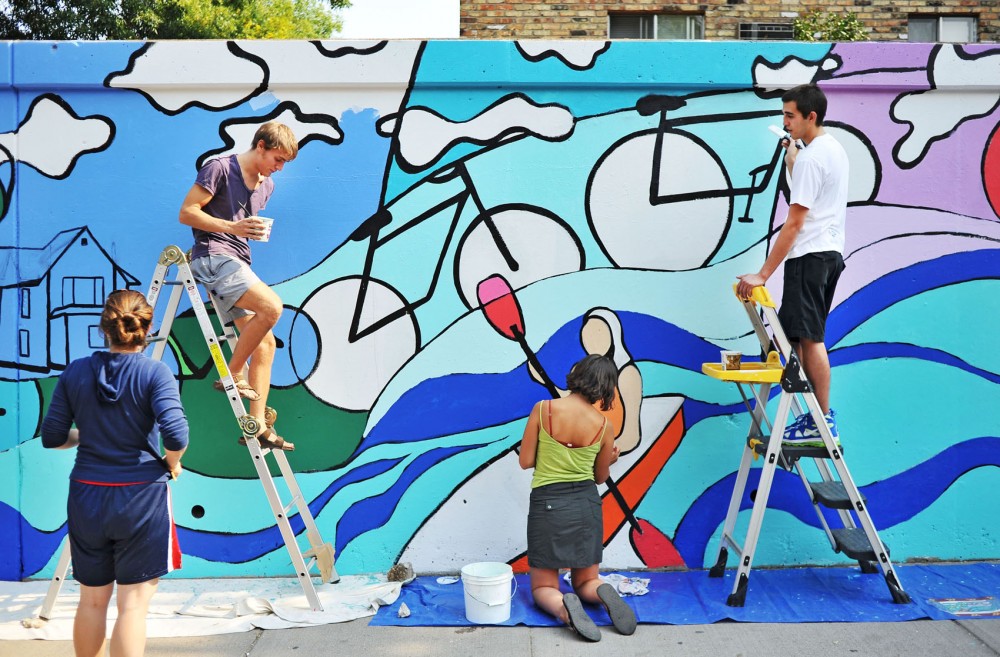Like most students living in Southeast Como, Adam Arling walked along 15th Avenue nearly every day. Where most people see a rusting, dimly lit underpass, Arling saw a blank canvas and an opportunity for building community.
“Sometimes when people come in at the beginning of the year they think ‘Hey, this is a student neighborhood,’ and that might affect how they live in the neighborhood and how neighborly they can be,” Arling said. “There’s a lot more to the neighborhood than the students who live in it.”
He set out to create a mural that would unite students and long-term residents in the University of Minnesota community.
After two years of financial, artistic and political challenges, the Gateway Mural Project is finally underway. Volunteers began painting the mural Saturday, and the project will conclude next weekend.
Community workshops
Last August, the project hired local artists Sara Udvig and Carly Schmitt to paint the mural.
The pair organized design workshops throughout the fall and winter where community groups gathered to discuss what they wanted to see in the mural.
“It really seemed like an incredible opportunity to bring these two groups a little closer together,” Udvig said. “To get the well-established, long-term resident a little more in touch with the student next door.”
They met with residents of the Students’ Co-op, community gardeners in Como, children from the Marcy Open School and the Southeast Seniors group.
Xiaolu Wang, a Students’ Co-op resident and cinema and media culture junior, documented the workshops. Wang said she especially liked going to the senior workshop and hearing their stories about growing up in the area.
Schmitt and Udvig then combined ideas from all of the workshops into a final mural design, which volunteers are painting using a paint-by-numbers approach.
Water is a motif throughout the mural: it flows through the University, the Stone Arch Bridge and community gardens.
“If the participants look closely at the mural, they’ll see something unique to their workshop, unique to their words,” Udvig said. “We really tried to get it all in there.”
Institutional hurtles
When the project began, Arling was a member of the Student Neighborhood Liaisons, a University of Minnesota group that focuses on strengthening relationships between students and the surrounding community.
They had originally hoped to paint all of the walls in and around the underpass, but budgetary and institutional challenges have reduced the area of the mural to two retaining walls on the east side.
Arling said much of the project’s first year involved getting approval from adjacent property owners, the Como and Marcy-Holmes neighborhood associations and the city. The liaisons also had to attain grants to fund the project.
“In a community project like this, you need community input, and often community input can be all over the place,” he said. “So trying to balance all of those was difficult.”
Student turnover
Last August, Arling took a new job working on a political campaign. Liaison Ryan Pusch took over the role of lead organizer and the group hired artists to help create the mural.
The turnover involved with being a student organization further delayed the project, sources said.
“There was definitely a huge standstill,” history senior and liaison Chris Yahnke said. “With our program there’s really a lot of turnover of student workers, so there’s a lot of starting and stopping.”
Yahnke said the liaisons try to maintain continuity by keeping some students, like Arling and Pusch, as part-time workers after graduation.
John Lencowski, who lived with Arling in Como for two years, said he was skeptical that the project could survive its numerous delays.
“I didn’t actually believe it was going to happen until I came here to paint,” he said Saturday.
Budget problems
Arling said the liaisons have been paid for their time working on the project. To hire the artists and pay for materials, the project received grants from the University’s Good Neighbor Fund and the Metropolitan Regional Arts Council totaling a little less than $10,000, Pusch said.
According to Schmitt, she and Udvig have only been paid for a fraction of their time, but they are too personally invested in the project to quit.
“The compensation is worse than what we would get if we would have worked at McDonald’s,” Schmitt said. “Which, of course, happens a lot in the arts, but that’s the problem: You get your heart involved, too. So we’ve come too far to really walk away from it.”
Arling and Pusch said they were aware of how much time the artists have put in, and the liaisons are trying to gather donations to pay them more.
A new model
Despite the pay problems, Udvig said the guidance the liaisons received from the artists will make future public art projects smoother and more efficient.
“We’ve really left them with a model,” Udvig said. “Now if they want to accomplish something this big, they really know how to do it.”
Arling said he hopes younger students will use this new model to paint the remaining walls on 15th Avenue, and long-term residents will see students taking responsibility for the neighborhood.
“We’ve got a whole wide range of people coming to help,” he said. “This is going to be a visual cue for people coming in and out: seeing who’s painting and who has a stake in the neighborhood.”








